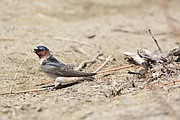Cliff swallows build nests from mud
BONNERS FERRY — During the past several weeks I have been observing a remarkable darting bird. In fact he is so quick at times he is hard to follow in flight.
The first time I saw him was about two weeks ago, flying under the Deep Creek Bridge where Deep Creek flows into the Kootenai River about three miles west of Bonners Ferry. I knew it was a swallow but I consulted my “Birds of Idaho” field guide for identification. After further research I discovered the bird was a cliff swallow. The cliff swallow is a colony nester and will carry balls of mud up to a mile in his beak to construct his nest.
Busy flocks of cliff swallows often swarm around bridges and overpasses in summer, offering passers-by a chance to admire avian architecture and family life at once. Clusters of their intricate mud nests cling to vertical walls, and when a cliff swallow is home you can see its bright forehead glowing from the dim entrance. These common, sociable swallows are nearly always found in large groups, whether they’re chasing insects high above the ground, preening on perches, or dipping into a river for a bath.
When a cliff swallow has had a hard time finding food, it will watch its neighbors in the nesting colony and follow one to food when it leaves. Although sharing of information about food at the colony seems unintentional, when a swallow finds food away from the colony during poor weather conditions it may give a specific call that alerts other cliff swallows that food is available. By alerting other swallows to a large insect swarm an individual may ensure that the swarm is tracked and that it can follow the swarm effectively.
It has been observed that within a cliff swallow colony some swallows lay eggs in another swallow’s nest. Sometimes the swallow may lay eggs in its own nest and then carry one of its eggs in its bill and put it in another female’s nest.
When the cliff swallows leave their nests they congregate in large groups called creches. A pair of swallows can find its own young in the creche primarily by voice. Cliff swallows have one of the most variable juvenal plumages, and the distinctive facial markings may help the parents recognize their chicks by sight also.
Other swallows of Idaho include the barn swallow, the tree swallow and the violet-green swallow. The barn swallow has a blue back and deeply forked tail. The tree swallow is similar in size to the cliff swallow and violet-green swallow, but lacks any tan-to-rust color of the cliff swallow and any emerald green of the violet-green swallow.
The oldest cliff swallow recorded was a male and was at least 11 years, 10 months old when he was recaptured and rereleased for scientific purposes in California in 2004. He had been banded in Nebraska in 1993.
Spring is the height of nesting and a good time to explore the outdoors in Boundary County.



